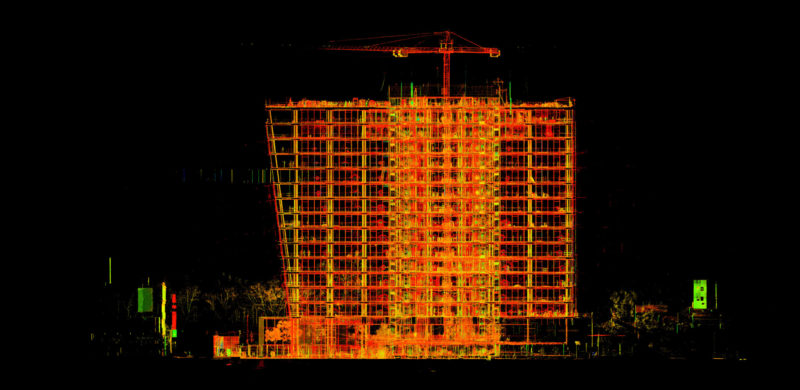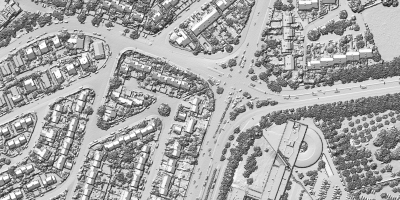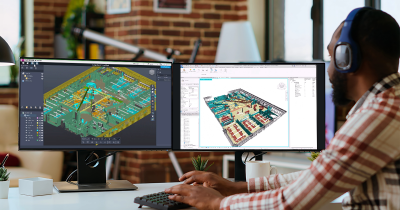Unless you’ve been hiding out for the past few years, you’ve heard of WeWork and its extremely popular co-working spaces. You’ve probably also heard that every WeWork space is designed, engineered, and constructed by WeWork’s employees. That means the company offers a fascinating case study for users of 3D capture technology, since it allows us to see what 3D capture technology can do when the walls separating the stages of the building lifecycle have disappeared.
WeWork allows us to ask, What’s possible when there’s buy-in and data sharing at every level?I caught up with Thad Wester, senior reality capture specialist at WeWork to find the answer.
Sean: What brought you to WeWork?
Thad Wester: I joined WeWork in 2015, and prior to that, I was running a successful scanning company but felt that I had more to learn. I was particularly interested in understanding how scanning drives value on projects. As a consultant, you would turn over countless numbers of point clouds and discover the client only uses it for the fly-through or just to make a model more accurate. At WeWork, there are discussions around the purpose of having a model. We see its value from a programming, design, build, construction, and project management standpoint. That was exciting, so I joined.
What does WeWork do, and why reality capture is crucial to the company’s operations?
WeWork is a platform for creators. We provide startups, freelancers, small businesses, and Fortune 500 companies with space, services and community so that they can focus on doing what they love. Behind the scenes of this mission is a large and fast-growing 600+ person “Buildings” team that is responsible for the design, development, engineering, and construction of each WeWork location.
Reality capture is critical to our mission at WeWork because in order to design and build the best product and space for our members, we need to understand every detail of the existing condition we are building within. Over 50% of the buildings WeWork developments are Class B properties, which are in need of upgrades. These locations are typically older structures with a bit of a patina, making them difficult to measure traditionally. Square footage, columns and beam locations, ceiling height, floor flatness even aiding the physical layout of our design onsite is controlled and regulated through our reality capture on WeWork Projects.
WeWork is fascinating to me because it’s vertically integrated—What’s the value of that in terms of using reality capture to its full potential? What does it enable you to do that you couldn’t otherwise?
Vertical integration at WeWork means we’re employing every aspect of the real estate development process. From sourcing to designing to running a building for 20+ years, we’re involved in every step to deliver the final product to our members. The benefit is that our reality capture process is informed through our constant interactions with hundreds of our designers, engineers, architects and BIM specialists.
This distinction within our organization is the most exciting part of working at WeWork because we have immediate insight into issues and can quickly develop solutions through reality capture. We are much more involved and have greater license than a consultant who is just delivering point clouds or a model.
Do you think WeWork is an example of what can happen for any owner who wants to bring laser scanning in house? Or is there something unique to WeWork that makes these kinds of benefits possible?
It takes more than just hiring people and buying a laser scanner. At WeWork we have buy-in for laser scanning from the executive level down. We have BIM and construction teams that bridge the gap between project teams and make our reality capture efforts worthwhile and consumable by stakeholders. You need this type of buy-in for it to be successful and WeWork’s reality capture team has this support.
How large is the WeWork Reality Capture team? How fast are you growing?
We have grown to a 10 person team and are actively looking to bring on people in San Francisco and London, and also other locations globally as well. In the past year we have scanned buildings in over 20 countries across the world, and our teams are traveling to 20 to 30 cities each month globally performing reality capture. Our team is definitely global!
We’re delivering more than 7,000 scans a month and we are making plans to double our scanning capacity by the end of this year. In addition to our scanning capacity, were also looking to bring on people for construction layout.
Can we dig into some specifics of how you use 3D data in ways that most owner/operators can’t? (I’m thinking real estate negotiations, pricing, etc).
We share the data from our laser scans to multiple teams at WeWork. For example, our real estate teams obtain true square footage measurements of our locations which is important in determining the economics of our buildings. Our designers use the accurate scans to optimize, and also confirm, the number of desks to be fitted within a floor.
Another example for leveraging the 3D data is that we provide floor flatness reports of our buildings — this data is so important for our construction teams and helping us recoup leveling costs from landlords By having just one accurate scan of our locations, WeWork’s project teams can get ahead of a myriad of issues.
You mention that the company is digging into 360° imagery. Why is that?
We think about laser scanning as the heavy duty stuff, and we will probably always want to invest the time and energy into the highest quality data to build an accurate foundation for our projects. But we also see a lot of opportunity for reality capture beyond a laser scan. For instance 360 cameras and other handheld tech reduce cost and time for capturing a space. These tools can provide us ways to perform reality capture more frequently without being tied to a “heavy” scanning approach.
What kind of tools are you using for this 360° capture?
We are finding tools and tech like Theta 360 cameras very useful. We’ve distributed the cameras to our regional teams in Shanghai, London, Buenos Aires, Tokyo, San Francisco, and Bengaluru to capture locations, and built functionality into our internal software. This allows us to share this data with our project teams and consultants.
Do you imagine it’s enough to get a good, accurate scan up front and then move into regular capture with a 360° device?
I think It makes a lot of sense. Photogrammetry has been used with great utility on outdoor construction sites with drones, but it hasn’t made a lot of progress indoors due to lack of GPS. We are testing some ideas right now and are experimenting with how we can leverage our ownership of the jobsite and our laser scanning expertise to leave control markers that persist over the course of construction to help scale and control image capture.
You’ve told me that you have started using 3D capture for construction layout. What do you mean by that?
Through feedback loops with WeWork project teams, we have learned that even if you laser scan and coordinate your design perfectly, if the crew in the field doesn’t place it in the right spot, the effort was all for nothing.
Many of the more advanced construction techniques we’re implementing require accurate layout. So, our reality capture group began working on a way to improve the layout process. What we have been able to do is to leverage our scan data as a control network, which has enabled us to increase the accuracy of our trades installation.
The only reason this works is because we have the scan data to begin with on projects, the reality capture expertise in-house and are vertically integrated and therefore reap the long term rewards of accurate layout onsite.








